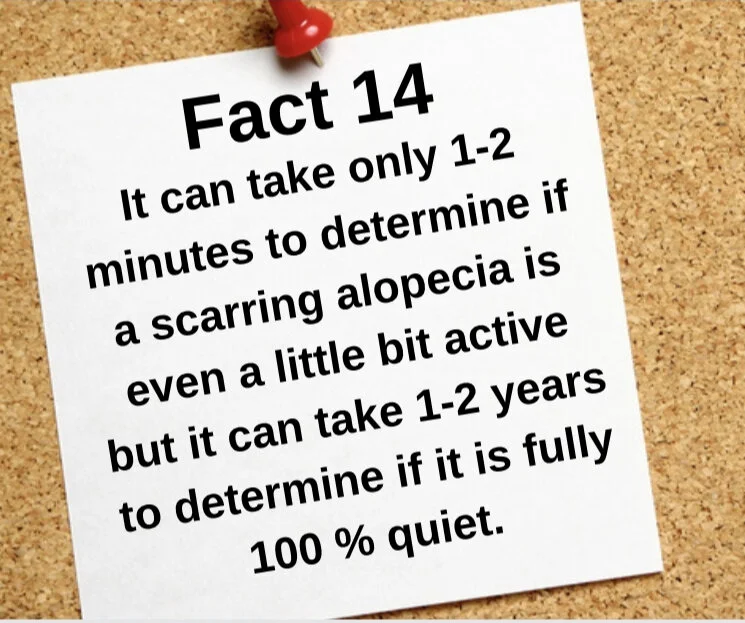National Scarring Alopecia Awareness Month (Day 14, Fact 14): Determining a Scarring Alopecia is Truly Quiet (Inactive) Takes Time
Patience is Required to Determine if A Scarring Alopecia is Truly Quiet
It is easier to determine if a scarring alopecia is a little bit active than determine if it is fully 100 % quiet.
Generally speaking, a clinician can tell if a scarring alopecia is “active” when they meet a patient at an initial appointment. The patient may report they are rapidly losing hair. They may have increased shedding. They may have itching, burning or pain. The clinician may notice the scalp is red and inflamed. The pull test may be positive. Contrary to what many believe, one can never be certain a scarring alopecia is truly “quiet” at an initial appointment. That takes a second appointment - after extended gap of time has elapsed.
It is important, of course, to determine if a scarring alopecia is active or quiet. If a scarring alopecia is active, there is a risk of further hair loss. The patient might also continue to experience troublesome symptoms like itching, burning or tenderness (although symptoms can still be absent even though a scarring alopecia is active). Patients with active scarring alopecia need additional treatment to reduce the disease activity.
A patient with a truly quiet or inactive scarring alopecia does not need any additional treatment. It could be that the treatment plan they are using is perfect and they simply need to continue these treatments. In some cases, the scarring alopecia is quiet because it has truly gone to sleep or burnt out. This is a special case where medications are no longer needed because the disease has stopped.
A scarring alopecia can also look quiet to the clinician and to the patient despite the fact that it is still active. For this reason, one can never say a scarring alopecia is quiet at a first appointment. If the scarring alopecia stays quiet over a period of long observation - meaning there is no further hair loss - it’s a pretty good indication the scarring alopecia is quiet.
Situations to Know: Scarring Alopecias that Look Quiet But are Often Not
There are a few clinical situations to know about that will easily fool the clinician. First, central centrifugal cicatricial alopecia (CCCA) often looks quiet even when it is not. I see far to many patients who are told their CCCA was inactive and so they were told to stop medications. What happened to many of these patients? They lost more hair. One must be careful not to let the relatively non inflammatory nature of CCCA fool you. Photos taken every 3-6 months will help determine whether the scarring alopecia is quiet or not.
The second situation of note is the sideburn area in frontal fibrosing alopecia (FFA). Even when active- the sideburn area of FFA often lacks the perifollicular redness and scale that the frontal scalp has. And so a common mistake is for the clinician to notice the area is fairly uninflamed looking and conclude the disease is quiet
Concluding a scarring alopecia is 100 % quiet is not difficult in most cases. It simply requires the following to be true: The patient has experienced no further hair loss when two sets of photos 2 years apart are carefully compared. Ideally the patient also reports no itching or burning or tenderness either but if hair loss has not progressed over a two year period it may be that these symptoms are coming from some other scalp process (such as seborrheic dermatitis or psoriasis) or coming from a scalp nerve issue (i.e. a dysesthesia) rather than from an active scarring alopecia. Photos are most important.
In addition, usually redness goes away when a scarring alopecia transitions from active to inactive - but not always. In some uncommon situations, there is a degree of redness that persists. As a default though, I would always be worried about redness as a sign of ongoing inflammation. However sometimes redness is coming from dilated blood vessels that resulted from chronic use (and overuse) of topical steroids. The redness stays around despite the fact the scarring alopecia is quiet. Does the patient need stronger medications and more drugs to suppress an active scarring alopecia in this case? No. the disease is quiet and could not become any quieter.
The key goal of treating scarring alopecia is to get the disease to become quiet. Determining if it is truly quiet takes a bit of patience. Sometimes a quiet appearing scarring alopecia reactivates months in the future and sometimes a patient with a quiet appearing scarring alopecia still goes on to lose more hair despite the fact that it looked quiet on the day of the appointment. These are not inactive scarring alopecias but rather scarring alopecias that simply appeared so.
This article was written by Dr. Jeff Donovan, a Canadian and US board certified dermatologist specializing exclusively in hair loss.

